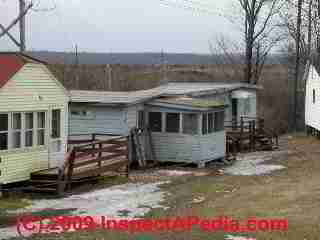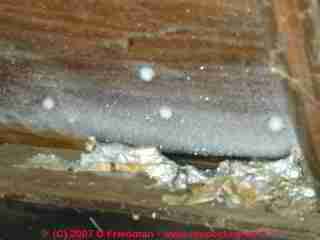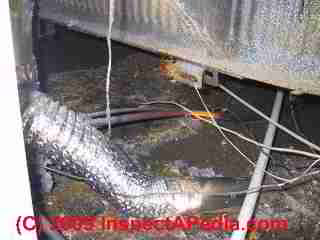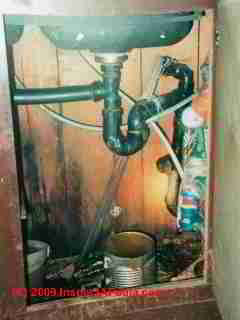 Manufactured / Mobile Home Leaks & Moisture
Manufactured / Mobile Home Leaks & Moisture
Causes, risks, repairs for wet or high moisture in mobile homes
- POST a QUESTION or COMMENT about the causes & risks of leaks & moisture in manufactured homes, mobile homes, mobile home, caravan, static caravan or trailer or doublewide: leak or high moisture level diagnosis procedures, repair, & maintenance
Leaks or moisture problems in Double-Wides, Mobile Homes, Trailers or Manufactured Housing: what are the causes, inspection procedures, & repairs needed.
Included in this article series are all of the major parts and systems of manufactured or mobile home structures and field inspection procedures as well as common hidden problem and common repair procedures.
InspectAPedia tolerates no conflicts of interest. We have no relationship with advertisers, products, or services discussed at this website.
- Daniel Friedman, Publisher/Editor/Author - See WHO ARE WE?
Leaks & Moisture in Manufactured Homes, Doublewides, Caravans & Mobile Homes
Question: How can I track down what's causing high moisture in a doublewide manufactured home?
I have a double wide manufactured home that I'm renovated. It has vinyl siding and perforated soffits common on manufactured homes.
We've noticed moisture high in the walls all around the home and can't identify the cause. Any ideas? Thank you, - T.B. - Colorado
Reply:
A competent onsite inspection by an expert usually finds additional clues that help accurately diagnose a problem with too much moisture in a home. That said, gee, with absolutely no information whatsoever about the home you mention, I'd be just arm-waving to offer a specific diagnosis.
But I can suggest some directions of investigation for tracking down a moisture problem:
Generally the approach is to find the water sources and water or moisture traps. That is, high indoor moisture, enough to put condensation on walls, might be tracked down to one or both of:
- Common mobile home leaks or moisture sources
that are wetting the building interior or its ceiling, wall or floor cavities or space below. These could be leaks from outside such as roof leaks, or leaks in the home's plumbing supply or drain piping, detailed
at MOBILE HOME PLUMBING
or very common, leaks around mobile home windows or doors
See MOBILE HOME EXTERIOR DEFECTS
or high mobile/manufactured home indoor moisture could be from indoor moisture generation by cooking, showers, plants, even plumbing leaks inside. the home
Watch out: some more-subtle indoor moisture sources can point to urgent life-safety hazards such as improperly-vented gas heaters or water heaters. See details at
UN-VENTED GAS HEATER SAFETY
We've also see that because on many manufactured/mobile homes the water heater is installed in a tiny closet accessed only from an outside doorway, a leak at the water heater may continue for so long that the heater itself is dangerous or it may have leaked so much as to have rotted the floor on which it is supported.
Those details are
at MOBILE HOME WATER HEATERS - Traps that keep moisture inside the mobile or manufactured home
because it is not adequately vented.
Indeed from your note I infer that there is a gabled (peaked/sloped) roof over the home, but we can't be sure that it has working venting or just some perforated soffit panels placed over solid plywood soffits.
Or you may have soffit intake but no ridge outlet venting. - Crawl spaces as sources of manufactured or mobile home high moisture levels
for signs of water entry right in the crawl itself; the skirt around the mobile home can keep the area from drying out.
See MOBILE HOME CRAWL SPACES for more details.
If I'm right that you're in Colorado, you're not in such a high humidity area as the Southeastern U.S. That in turn makes me wonder if there is not either water below the home or leaks in or into it from roof, windows or doors (notorious leakers on older manufactured homes).
If the moisture is uniform around all of the interior of the home I suspect it could be coming from a source that would equally wet the whole structure - below the entire structure up through floors, or leaks across a wide area of roof. Observing moisture high on walls may just indicate where the cool walls are in contact with warmer, high-moisture-content air inside the home. (Warm moist air rises).
If your renovation permits, you might need to make some test cuts to be sure you know where water is and is not, and to be sure you're not renovating by putting a new skin over a rotting or inset infested structure.
Sorry I can't be smarter but that's about as much arm-waving as I can dare with no more information. If you'd like to send some photos or further description of what's there and what you're seeing, that may permit some further suggestions.
See
- WATER ENTRY in BUILDINGS where collect a series of building moisture or water entry diagnosis & cure articles that might be helpful.
See also the advice at
- MHRA MOISTURE PROBLEMS in MANUFACTURED HOMES [PDF] (2000) ISSN 1529-3424 Manufactured Housing Research Alliance [PDF] - retrieved 2017/06/05, original source: www.huduser.gov/portal/publications/moisture.pdf
Introduction excerpt:
This manual is designed to assist manufacturers, retailers, setup crews, and homeowners to recognize and solve moisture problems in manufactured homes. It reviews the symptoms of typical problems, outlines preventive measures, and provides solutions pertinent to home design, manufacture, installation, operation, and maintenance.
Follow-Up: wet walls traced to frost or ice in the home eaves and attic

Thanks for the reply. I managed to find a manufactured home installer who immediately knew what I was talking about. It turns out all this is a universal problem with manufactured homes (and some stick built homes) in cold, high wind areas.
The soffits are vented continuously. Snow actually drifts inside the soffit then, when the weather warms, melts and some water runs down the walls. As this can happen many days after the initial precipitation it’s often mistaken for a condensation issue.
The installer didn't have any suggestions for a solution. In fact, he said if I came up with anything to let him know. Any ideas?
Reply:
We have seen several points of frost or even ice accumulation at house eaves and even deeper into the attic in uninsulated HVAC ductwork.
Clues that point to the attic ice or frost accumulation as the source of indoor leaks and moisture
I think a diagnostic clue that can help track down apparent building leaks or moisture on walls that originates in the attic may be the observation of leaks in a warming weather trend after a long cold spell.
Also the moisture shows up only on the exterior walls, not on building interior walls. It doesn't have to be snow blowing into the soffits - which is unusual; anything that allows moisture condense, collect, and freeze in the attic or in attic HVAC ducts can produce such leaks when things thaw out.
The cause your installer cited, snow drifts in the soffits, is possible but more common are some of these other problems that can produce the same symptoms:
- ROOF ICE DAM LEAKS -
a combination of inadequate insulation and/or improper attic ventilation causes ice dams along roof edges or eaves; water backs up above the ice dam and leaks through the roof, into attic and walls below. - WIND WASHING INSULATION at EAVES -
in high wind areas and homes using blown-in or loose-fill attic insulation, winds can push back insulation from the outer edges of the attic, exposing the wall top and ceiling area close to exterior walls to heat loss, condensation, ice and frost formation, and later, when weather warms, melting ice and frost show up as leaks in the interior - WATER & ICE IN DUCT WORK -
occurs when uninsulated or under-insulated HVAC ducts in a cold attic ceiling receive moist indoor air during freezing weather.
How do we fix these problems of ice and frost formation in the attic ... it depends. First let's accurately diagnose the cause by a careful inspection in the attic. Wind-wash will be obvious - insulation will have been disturbed. Ice dam leaks leave characteristic stains that we illustrate in that article.
- Fixing ice dam leaks
add insulation, or add ice and water shield under shingles at roof eaves; improve attic venting, including not just soffit intake but adequate ridge outlet - Fixing wind-washed insulation
at house eaves: replace insulation, or replace loose fill with batt insulation, held in place or air flow above assured using baffles in the eaves that let soffit intake air pass over not through the insulation - Fixing ice and frost in ductwork:
correct indoor moisture sources, close off ceiling registers for A/C systems that are not used in cold weather; insulate the HVAC duct work
Details about these attic frost, ice, or moisture problems that show up as "leaks or moisture on building walls" and how they are fixed are in the articles cited above.
At INSPECT ATTICS for MOISTURE or MOLD we discuss inspecting (and correcting) building attics for evidence of condensation, moisture, or even ice.
...
Continue reading at MOBILE HOME ROOF LEAKS, DEFECTS or select a topic from the closely-related articles below, or see the complete ARTICLE INDEX.
Or see these
Recommended Articles
- INSPECT ATTICS for MOISTURE or MOLD
- MOBILE HOMES, DOUBLEWIDES, TRAILERS - home
- MOBILE HOME CRAWL SPACES
- MOBILE HOME EXTERIOR DEFECTS
- MOBILE HOME HEATING SYSTEMS
- MOBILE HOME INSPECTIONS
- MOBILE HOME INSULATION BELLY WRAP
- MOBILE HOME INSULATION & VENTILATION
- MOBILE HOME SKIRTING
- MOBILE HOME SKIRTING CODES
- MOBILE HOME LEAKS & MOISTURE
- MOBILE HOME PLUMBING
- MOBILE HOME ROOF LEAKS, DEFECTS
- MOBILE HOME WATER HEATERS
- WATER ENTRY in BUILDINGS
Suggested citation for this web page
MOBILE / MANUFACTURED HOME LEAKS & MOISTURE at InspectApedia.com - online encyclopedia of building & environmental inspection, testing, diagnosis, repair, & problem prevention advice.
Or see this
INDEX to RELATED ARTICLES: ARTICLE INDEX to MANUFACTURED & MOBILE HOMES
Or use the SEARCH BOX found below to Ask a Question or Search InspectApedia
Ask a Question or Search InspectApedia
Try the search box just below, or if you prefer, post a question or comment in the Comments box below and we will respond promptly.
Search the InspectApedia website
Note: appearance of your Comment below may be delayed: if your comment contains an image, photograph, web link, or text that looks to the software as if it might be a web link, your posting will appear after it has been approved by a moderator. Apologies for the delay.
Only one image can be added per comment but you can post as many comments, and therefore images, as you like.
You will not receive a notification when a response to your question has been posted.
Please bookmark this page to make it easy for you to check back for our response.
IF above you see "Comment Form is loading comments..." then COMMENT BOX - countable.ca / bawkbox.com IS NOT WORKING.
In any case you are welcome to send an email directly to us at InspectApedia.com at editor@inspectApedia.com
We'll reply to you directly. Please help us help you by noting, in your email, the URL of the InspectApedia page where you wanted to comment.
Citations & References
In addition to any citations in the article above, a full list is available on request.
- [9] New York State: "Manufactured Homes: an installation guide for the code enforcement official," undated. [Div. of Code Enforcement & Admin. - 518-474-4073, George E. Clark, Jr., Director] - this is a guide tool, not an enforcement code or standard.
- [10] HUD State Administrative Agency (for 36 states) (NY: 518-474-4073) - for complaints
- [11] Manufactured Housing Institute, 2101 Wilson Blvd. Ste. 610, Arlington VA 22201 703-558-0400 Web: mfghome.org
- [12] NYMHA, 35 Commerce Ave., Albany NY 12206-2015 518-435-9859 800-721-HOME (they want the Star Program to provide for separate assessment of manufactured homes)
- In addition to citations & references found in this article, see the research citations given at the end of the related articles found at our suggested
CONTINUE READING or RECOMMENDED ARTICLES.
- Carson, Dunlop & Associates Ltd., 120 Carlton Street Suite 407, Toronto ON M5A 4K2. Tel: (416) 964-9415 1-800-268-7070 Email: info@carsondunlop.com. Alan Carson is a past president of ASHI, the American Society of Home Inspectors.
Thanks to Alan Carson and Bob Dunlop, for permission for InspectAPedia to use text excerpts from The HOME REFERENCE BOOK - the Encyclopedia of Homes and to use illustrations from The ILLUSTRATED HOME .
Carson Dunlop Associates provides extensive home inspection education and report writing material. In gratitude we provide links to tsome Carson Dunlop Associates products and services.



